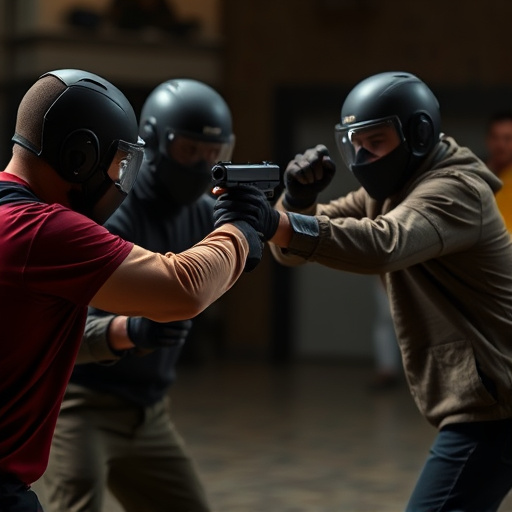Accidental firearm discharges pose significant risks in sensitive environments, especially for seniors with limited agility. Non-lethal self-defense weapons like stun guns and pepper spray offer a safer alternative, temporarily incapacitating attackers without causing permanent harm. Designing these tools requires user-friendly interfaces catering to reduced mobility and sensory capabilities, along with comprehensive training programs. Legal and ethical considerations are crucial, balancing personal safety with potential misuse, ensuring strict regulation and guidelines for accessibility and deployment while respecting senior autonomy.
Accidental discharge of firearms is a significant concern, especially among elderly users. This article explores non-lethal self-defense weapons as an alternative, focusing on mechanisms to prevent unintended firings and promote senior safety. We delve into the causes and risks of accidental discharges, providing an overview of non-lethal options suitable for seniors. Additionally, design considerations, training, legal aspects, and ethical implications are discussed to ensure effective prevention and responsible self-defense.
- Understanding Accidental Discharge: Causes and Risks
- Non-Lethal Self-Defense Weapons: An Overview
- Design Considerations for Senior Safety
- Training and User Experience: Ensuring Effective Prevention
- Legal and Ethical Aspects of Senior Self-Defense Mechanisms
Understanding Accidental Discharge: Causes and Risks
Accidental discharge, an unforeseen release of a weapon’s destructive force, poses significant risks, especially in sensitive environments where individuals may not be prepared for such incidents. Non-lethal self-defense weapons, designed to incapacitate temporarily without causing permanent harm, offer a safer alternative for seniors and others seeking personal protection. These tools are crucial for mitigating the dangers associated with accidental discharge, as they provide a means of self-defense that minimizes the risk of fatal consequences.
Various factors contribute to accidental discharges, including user error, mechanical failures, or sudden movements that trigger the weapon’s firing mechanism. Seniors, who may have reduced physical agility and slower reaction times, are particularly vulnerable during such incidents. Non-lethal self-defense weapons, with their focused energy outputs like stun guns or pepper spray, enable users to defend themselves effectively while reducing the likelihood of causing permanent injury or death, making them ideal for older individuals concerned about personal safety.
Non-Lethal Self-Defense Weapons: An Overview
Non-lethal self-defense weapons are designed to protect individuals without causing permanent harm or death, making them ideal for seniors looking to secure their safety. These tools aim to incapacitate or deter attackers through non-fatal means, such as stun guns and pepper spray. Stun guns emit an electric shock that temporarily paralyses the target, allowing the user to escape or seek help. Pepper spray irritates the eyes, nose, and throat, creating a temporary but effective barrier against assault.
For seniors, non-lethal self-defense weapons offer peace of mind and enhanced security. They can be easily concealed and are less likely to cause severe injury compared to traditional firearms. This option is particularly appealing for those who may have physical limitations or prefer not to handle lethal weaponry. By choosing non-lethal options, seniors can protect themselves while adhering to their personal safety preferences and comfort levels.
Design Considerations for Senior Safety
When designing prevention mechanisms for accidental discharges, particularly with non-lethal self-defense weapons aimed at senior citizens, several key considerations come to the forefront. The primary focus should be on creating user-friendly interfaces that cater to reduced mobility and sensory capabilities often associated with aging. This includes intuitive triggers and simple, clear instructions to minimize the risk of incorrect handling.
Additionally, incorporating safety features such as lock mechanisms, quick-release safeties, and sensor-based activation systems can significantly enhance senior safety. Training programs tailored for older adults should accompany these weapons, teaching them how to effectively deploy the device while ensuring they understand the importance of responsible use. The goal is to empower seniors with tools for self-defense without compromising their well-being or introducing new hazards.
Training and User Experience: Ensuring Effective Prevention
Training and user experience play a pivotal role in ensuring effective accidental discharge prevention mechanisms, especially with non-lethal self-defense weapons designed for seniors. Comprehensive training programs tailored to older adults’ needs can significantly reduce mishandling risks. These programs should cover not just weapon handling but also scenario-based exercises that mimic potential self-defense situations. By familiarizing seniors with their devices and teaching them how to react calmly under pressure, the likelihood of accidental discharge decreases substantially.
User experience is another critical aspect. Non-lethal self-defense weapons for seniors should be designed with intuitive interfaces and simple controls. Easy-to-understand instructions and clear visual cues can make a significant difference in how users interact with the device. Regular practice sessions that reinforce proper usage can further enhance user confidence and reduce the chances of mistakes, ultimately fostering a safer environment for seniors who wish to protect themselves.
Legal and Ethical Aspects of Senior Self-Defense Mechanisms
In the context of accidental discharge prevention, particularly with non-lethal self-defense weapons designed for seniors, there are significant legal and ethical considerations to keep in mind. The primary goal is to ensure that individuals aged 65 and over have access to tools that can protect them without causing harm or death. This necessitates a balance between personal safety and the potential consequences of misuse, especially since elderly users might have reduced dexterity or cognitive abilities.
Legal frameworks must adapt to accommodate non-lethal weapons while still upholding ethical standards. This includes strict regulation on accessibility, training requirements for users, and clear guidelines on when and how such devices can be deployed. Ethical implications include respect for autonomy, preventing elder abuse, and ensuring that these mechanisms are used as last resorts only when all other preventive measures have failed.
Accidental discharge is a critical concern, especially when considering non-lethal self-defense weapons for seniors. By understanding the causes and risks, incorporating design features that cater to senior safety, providing comprehensive training, and addressing legal and ethical frameworks, we can enhance the effectiveness of these mechanisms. Non-lethal self-defense options offer a balanced approach, allowing seniors to protect themselves without causing lethal harm. Through thoughtful consideration and user-centric design, we can create tools that empower the elderly while ensuring their well-being and peace of mind.
